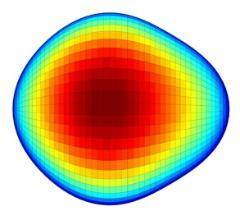Pear-Shaped Nuclei
P.A. Butler, D.T. Joss, R.D. Page
Our studies of octupole collectivity are motivated by the lack of understanding of reflection asymmetry in nuclei and by its important relevance to particular measurements of symmetry breaking phenomena. This is important for nuclear theory as there is a poor understanding of the nature of low-lying octupole collectivity in nuclei, with different interpretations (e.g., clustering phenomena, deformed mean field with different interactions etc.) for the observed phenomena in nuclei having strong octupole correlations in the mass region A~224. A central question is whether atomic nuclei can assume a permanent octupole distortion, or “pear” shape, or whether the instability is dynamic, with the nucleus undergoing octupole vibrations.

Beyond nuclear physics, atoms with octupole-deformed nuclei are very important in the search for permanent atomic Electric-Dipole Moments. The observation of a non-zero EDM indicates T- and P- (or equivalently CP-) violation that cannot be explained by the Standard Model (SM). CP violation has not yet been observed for processes governed by the strong and electromagnetic interaction. Measurements that give a limit on the EDM can provide the most important constraints on the many proposed extensions of the SM that give rise to CP violation. Octupole-deformed nuclei will have large nuclear “Schiff” moments due to the presence of nearly degenerate parity doublets (seen in odd mass nuclei) and large collective octupole deformation. Since the Schiff moment induces the atomic EDM, the sensitivity over non-octupole systems such as for 199Hg, currently providing one of the most stringent limits on an atomic EDM, can be improved by a factor of 100-1000. Essential in the interpretation of such limits in terms of new physics is a detailed understanding of the structure of these nuclei.
Our investigations of octupole shapes largely employ the method of Coulomb excitation. These experiments have been made possible by the unique capability of HIE-ISOLDE, at ISOLDE, CERN, to post-accelerate mass 200 radioactive ions. Coulomb excitation measurements can measure directly nuclear matrix elements and provide detailed tests of the effective interactions used in the descriptions of nuclei. We have demonstrated that it is possible to provide more precise information on the nature of the octupole collectivity through Coulomb excitation of radioactive radon (Rn) and radium (Ra) beams. By studying their behaviour under rotations, we have shown that Rn isotopes do not possess rigid pear-shapes, and hence are not ideal candidates for EDM searches. On the other hand, by measuring the only observable that provides unambiguous and direct evidence for enhanced octupole correlations, the E3 matrix element, we have shown that Ra-222 and Ra-224 have permanent octupole deformation. This information is important for the on-going searches for EDMs in radium atoms. In the longer term our programme of study will benefit from the ISOLDE Solenoidal Spectrometer (ISS), constructed by a Liverpool-led collaboration, that has initially been used to study single particle structure in exotic nuclei.